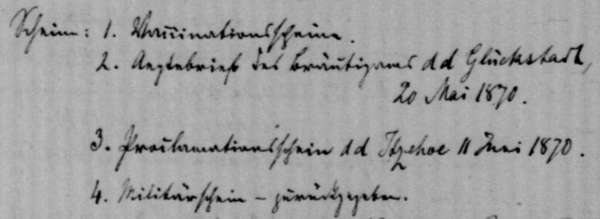No marriage without vaccination!
- 17. June 2017 - General, Genealogy, Germany, Historical Documents, Knowledge
What has a „Vaccinationsschein“ (vaccination certificate) to do with a wedding (and what is it)? Or is there something else written in the church book?
Is there any genealogist who doesn’t know the situation? Finally, you have found a document regarding a sought-after person, but you are not able to read everything. Even after deciphering the words, or after you think you might have deciphered them, you are not sure what to do with the information. Often, background information is necessary to understand what this is all about. Here is one of these cases. A church book of the parish Münsterdorf (Schleswig-Holstein) that is available at the Kirchenkreisarchiv (church district archive) in Wrist, Germany contains the following Detail:
You can read the following:
Scheine:
- Vaccinationsscheine.
- Aegtebrief des Bräutigames dd Glückstadt, 20 Mai 1870.
- Proclamationsschein dd Itzehoe 11 Juni 1870.
- Militärschein – zurückgegeben.
Translation:
Certificates:
- Vaccination certificates.
- Aegtebrief (Aegte letter) of the groom dd [abbr. for Latin de dato – after date] Glückstadt, 20 May 1870.
- Proclamationsschein (proclamation certificate) dd Itzehoe 11 June 1870.
- Military certificate – returned.
Obviously these are certificates that had to be submitted for marriage. But what are they actually about?
Vaccination as a requirement for marriage in Schleswig-Holstein
Let’s start with the „Vaccinationsschein“ (vaccination certificate; sometimes shortened to Vacc. Schein) that was mentioned at the beginning. You can probably figure out a lot, if you just look at the name. In German the term “Vaccination” (or Vakzination) isn’t used as often as in English. Still people might have the general idea that it probably is about the fact that a person was vaccinated. If you know, that this document was often called “Blatternschein” (variola certificate) as well, you know it’s not only any vaccination, but a very specific one. Namely it’s about a vaccination against variola or smallpox. But why was this important for a wedding?
To explain this we would like to give you some short information about the disease: smallpox was quite common in the 18th century and due to more frequent epidemics at the time even more disastrous than the pest. Even though the mortality rate was lower. Often, survivors had to live with lifelong damage, regarding not only their appearances (pockmarks), but also in the form of organ damage, blindness or deafness. But who once had smallpox, usually never got reinfected. Accordingly, it was early tried to immunize people with human smallpox. This procedure was dangerous as serious pox infections were possible. In 1796, the British physician Edward Jenner infected a boy with cowpox for the first time. This disease usually has a mild progression, but still an immunization against human smallpox was achieved. He called this method “Vaccination” (from Latin vacca – cow). It was the first disease for which a vaccination ever existed.
At the beginning of the 19th century, the procedure became known and was more and more used. Some clergymen helped by announcing vaccination dates or even by vaccinating themselves. By and by, several countries introduced vaccination laws. Amongst others Denmark (to which Schleswig-Holstein mostly belonged at the time) in 1810. But there was no official compulsory vaccination. The clergymen again had as companions of key life events like baptism, confirmation and wedding an important role in the enforcement of vaccinations. From 1810 onwards, no couple could marry without proving that they had a vaccination or the disease itself. Usually a vaccination certificate was presented that certified that a vaccination was performed. Still, not being vaccinated wasn’t punishable; a real compulsory vaccination was only introduced in 1871. In Germany an obligatory vaccination and revaccination was implemented in 1874. In 1980, the eradication of smallpox was finally declared.
„Aegtebrief“ and „Proklamationsschein“
In the extract of the church book above are some other interesting terms that might need a short explanation:
The „Aegtebrief“ (Aegte letter) is quite specific for Schleswig-Holstein, at least as a term in Germany. The Danish word “aegten” means “to get married”, therefore it translates as a marriage or wedding letter. If the wedding took place outside of the own parish, the fundamental requirements for a marriage had to be verified. Therefore a written certificate of the home parish had to be presented. It would state that the person was baptized, confirmed and unmarried (also testimonium integritatis).
A “Proclamationsschein” or “Proklamationsschein” (proclamation certificate) was necessary, if a person wanted to marry outside of its own parish as well. In the past the marriage had to be proclaimed three times prior to the wedding. This means it was announced in public, in the course of the service. It was a measure to make sure that no one had anything against the marriage and that no obstacles existed. If the wedding was supposed to be performed in another parish, it was necessary to get a written confirmation that the wedding was officially proclaimed in the home parish. This certificate had to be submitted in order to marry. In Germany, the secular equivalent was a notice of intended marriage that had to be put up in public until 1998.
These are only examples. Depending in the person and region, other certificates may be mentioned. Did you ever come across something similar during your Research?


0 comments